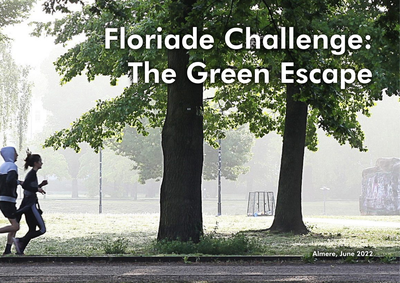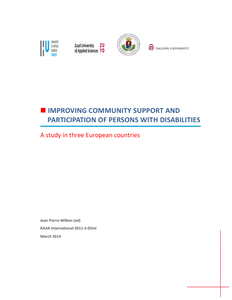Background Interprofessional education is promoted as a means of enhancing future collaborative practice in healthcare. We developed a learning activity in which undergraduate medical, nursing and allied healthcare students practice interprofessional collaboration during a student-led interprofessional team meeting. Design and delivery During their clinical rotation at a family physician’s practice, each medical student visits a frail elderly patient and prepares a care plan for the patient. At a student-led interprofessional team meeting, medical, nursing and allied healthcare students jointly review these care plans. Subsequently, participating students reflect on their interprofessional collaboration during the team meeting, both collectively and individually. Every 4 weeks, six interprofessional team meetings take place. Each team comprises 9–10 students from various healthcare professions, and meets once. To date an average of 360 medical and 360 nursing and allied healthcare students have participated in this course annually. Evaluation Students mostly reported positive experiences, including the opportunity to learn with, from and about other healthcare professions in the course of jointly reviewing care plans, and feeling collectively responsible for the care of the patients involved. Additionally, students reported a better understanding of the contextual factors at hand. The variety of patient cases, diversity of participating health professions, and the course material need improvement. Conclusion Students from participating institutions confirmed that attending a student-led interprofessional team meeting had enabled them to learn with, from and about other health professions in an active role. The use of real-life cases and the educational design contributed to the positive outcome of this interprofessional learning activity.
DOCUMENT

Almere is a green city where the greenery extends into the centre through a framework of nature, forests, parks and canals. With this green environment, Almere fulfils an important condition for a liveable city, where it is pleasant to live and work. An important goal for the municipality is to challenge its residents to develop a healthy lifestyle by using that green framework.But what really motivates Almeerders to go outside to exercise, enjoy the surroundings and meet each other? Are there sufficient green meeting or sports facilities nearby? Could the routes that connect the living and working environment with the larger parks or forests be better designed? And can those routes simultaneously contribute to climate adaptation?With the Green Escape Challenge, we invited students and young professionals to work on these assignments together.
DOCUMENT

This investigation explores relations between 1) a theory of human cognition, called Embodied Cognition, 2) the design of interactive systems and 3) the practice of ‘creative group meetings’ (of which the so-called ‘brainstorm’ is perhaps the best-known example). The investigation is one of Research-through-Design (Overbeeke et al., 2006). This means that, together with students and external stakeholders, I designed two interactive prototypes. Both systems contain a ‘mix’ of both physical and digital forms. Both are designed to be tools in creative meeting sessions, or brainstorms. The tools are meant to form a natural, element in the physical meeting space. The function of these devices is to support the formation of shared insight: that is, the tools should support the process by which participants together, during the activity, get a better grip on the design challenge that they are faced with. Over a series of iterations I reflected on the design process and outcome, and investigated how users interacted with the prototypes.
DOCUMENT

Illicit data markets have emerged on Telegram, a popular online instant messaging application, bringing together thousands of users worldwide in an unregulated exchange of sensitive data. These markets operate through vendors who offer enormous quantities of such data, from personally identifiable information to financial data, while potential customers bid for these valuable assets. This study describes how Telegram data markets operate and discusses what interventions could be used to disrupt them. Using crime script analysis, we observed 16 Telegram meeting places encompassing public and private channels and groups. We obtained information about how the different meeting places function, what are their inside rules, and what tactics are employed by users to advertise and trade data. Based on the crime script, we suggest four feasible situational crime prevention measures to help disrupt these markets. These include taking down the marketplaces, reporting them, spamming and flooding techniques, and using warning banners. This is a post-peer-review, pre-copyedit version of an article published in Trends in organized crime . The final authenticated version is available online at https://doi.org/10.1007/s12117-024-09532-6
DOCUMENT
This project builds upon a collaboration which has been established since 15 years in the field of social work between teachers and lecturers of Zuyd University, HU University and Elte University. Another network joining this project was CARe Europe, an NGO aimed at improving community care throughout Europe. Before the start of the project already HU University, Tallinn Mental Health Centre and Kwintes were participating in this network. In the course of several international meetings (e.g. CARe Europe conference in Prague in 2005, ENSACT conferences in Dubrovnik in 2009, and Brussels in April 2011, ESN conference in Brussels in March 2011), and many local meetings, it became clear that professionals in the social sector have difficulties to change current practices. There is a great need to develop new methods, which professionals can use to create community care.
DOCUMENT

In this paper we explore the influence of the physical and social environment (the design space) son the formation of shared understanding in multidisciplinary design teams. We concentrate on the creative design meeting as a microenvironment for studying processes of design communication. Our applied research context entails the design of mixed physical–digital interactive systems supporting design meetings. Informed by theories of embodiment that have recently gained interest in cognitive science, we focus on the role of interactive “traces,” representational artifacts both created and used by participants as scaffolds for creating shared understanding. Our research through design approach resulted in two prototypes that form two concrete proposals of how the environment may scaffold shared understanding in design meetings. In several user studies we observed users working with our systems in natural contexts. Our analysis reveals how an ensemble of ongoing social as well as physical interactions, scaffolded by the interactive environment, grounds the formation of shared understanding in teams. We discuss implications for designing collaborative tools and for design communication theory in general.
MULTIFILE

Op 26 en 27 februari 2025 hebben 44 studenten van de opleiding vastgoedkunde onderzoek gedaan naar ontmoetingsplekken. Zij zijn aan de slag gegaan met de vragen ‘Wat zijn de wensen en behoeften van bewoners omtrent ontmoetingsplekken?’ en ‘In hoeverre hebben bewoners behoefte om als zij vragen hebben, op een laagdrempelige manier in contact te komen met de wijkteams van Mijn Buurt Assen (MBA)?’ Voor dit onderzoek zijn zij in duo’s de wijken Marsdijk, Noorderpark, Peelo, Baggelhuizen en Kloosterveen ingegaan om in gesprek te gaan met bewoners. Dit verslag beschrijft de resultaten van deze twee dagen.
DOCUMENT
Websites placing cookies on your computer to track your browsing behavior. TikTok stores your personal data in China. Are you aware of what products, services, and organisations do with your personal data? It is often not obvious. Our digital lives are becoming more and more prominent. We are now meeting each other virtually for work and leisure, and are spotted and traced without our knowledge, both in physical places (public areas and streets) and in virtual spaces. Technology is developing rapidly and policy makers are not able to keep up, resulting in unknown threats for citizens in modern society. Moreover, technology can lead to inequality and exclusion, as demonstrated in the Dutch childcare benefits scandal. The aim of the Inholland Digital Rights Research Team, co-founded by Professors Wina Smeenk, Ander de Keijzer and Ben Wagner, is to focus their work on the social, economic, cultural, communication, design and technological elements that can lead to a digitally responsible society. This means that we want to be part of the debate and research on how technology in our digital age can contribute to the quality of peoples’ lives: how can people benefit from the digital society and how are they hindered, or even worse, excluded from partaking in our digital society. We do this in our research lines, as well as in the sustainable media lab courses and the data-driven minor.
DOCUMENT

Walking meetings are a promising way to reduce unhealthy sedentary behavior at the office. Some aspects of walking meetings are however hard to assess using traditional research approaches that do not account well for the embodied experience of walking meetings. We conducted a series of 16 bodystorming sessions, featuring unusual walking meeting situations to engage participants (N=45) in a reflective experience. After each bodystorming, participants completed three tasks: a body map, an empathy map, and a rating of workload using the NASA-TLX scale. These embodied explorations provide insights on key themes related to walking meetings: material and tools, physical and mental demand, connection with the environment, social dynamics, and privacy. We discuss the role of technology and opportunities for technology-mediated walking meetings. We draw implications for the design of walking meeting technologies or services to account for embodied experiences, and the individual, social, and environmental factors at play.
DOCUMENT
